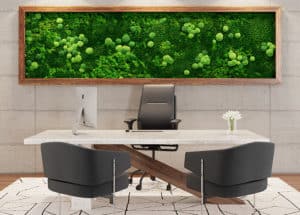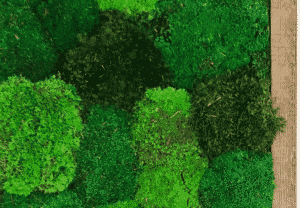Biophilia is defined as the innate human instinct to connect with nature. Research shows that biophilic design in workspaces has wide-ranging psychological and physiological benefits, including improved cognitive function, psychological well-being, and physical health.
in recent years, more interior designers and building managers have taken steps to artfully integrate the biophilic experience into architecture and interior design. To reap these benefits, here’s how to incorporate it into your workplace.
1. Appeal to the Senses
All of our senses play into our experience when we are immersed in a natural environment. Consider installing a preserved moss wall, using window treatments to boost ventilation, or integrating naturally occurring rounded forms like domes and arches. Using sensory variation, biophilic design helps employees feel more energized, creating a positive impact on work environments.
2. Take Advantage of Natural Changes in Lighting
As many people re-adjust to working in the office, spending so much time indoors is a common complaint. The solution? Incorporate natural lighting into your workplace environment.
Solutions like windows, skylights, solar tubes, and light shelves can link people to the outdoors by mimicking their circadian rhythm. For example, in biophilic office design, natural lighting enhances visual comfort by counteracting the flatness of artificial lighting and bright screens. In turn, natural lighting helps employees and clients feel more engaged, alert, and productive.
3. Incorporate the Presence of Water
The presence of water enhances the biophilic experience. By appealing to multiple senses, water creates a soothing, mood-boosting, and restorative indoor space.
Interventions incorporating water into interior design have several health benefits, including lowered heart rate, blood pressure, and better memory. According to research, the presence of water also fosters feelings of tranquility. Water is ideal for introducing natural ambiance in hotels, offices, health care facilities, and other indoor spaces.
4. Decorate with Natural Foliage
Natural greenery and biomorphic patterns can also help your staff or clients feel more connected to nature. Whenever possible, include foliage and greenery in climbing gardens, preserved moss planters, or decorative moss mosaics.
Quiet Earth Moss decorative moss planters are a simple solution for any indoor environment. They are made using ezoBord, and are a great alternative to hard surface planters, offering the added benefits of acoustic sound dampening, space division, and even social distancing within larger spaces.
5. Use Natural Materials
Wherever possible, use natural materials, such as sustainable bamboo, in furniture and paneling. Natural wood is an important element of biophilic design, doubling as a building material and structural element. In offices, hospitals, and hotels, well-executed wall and ceiling designs can create feelings of well-being and comfort.
In addition, using complementary biophilic floor designs both inside and outside of a building can contribute to balance and harmony. It can also create one holistic indoor and outdoor space, which is a great way to bring the outdoors in.
Transform Your Business with Biophilic Design
Ultimately, biophilic design helps people feel more comfortable by creating a rejuvenating indoor environment.
As your staff and clients adjust to the post-pandemic world, our maintenance-free, anti-microbial preserved moss walls, decorative moss mosaic panels, and moss planters can promote an improved sense of connection and comfort in the workplace. Upgrade your business today with the natural beauty of Quiet Earth Moss.


